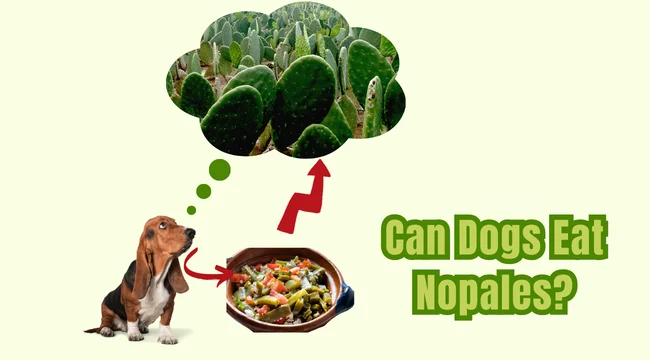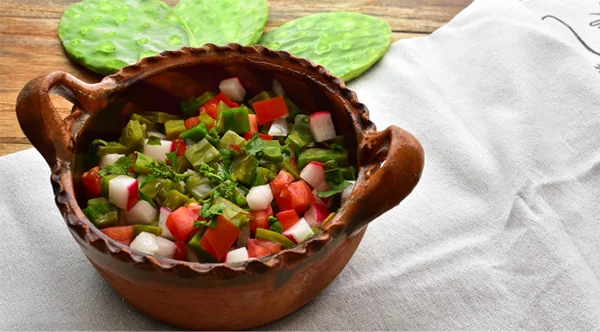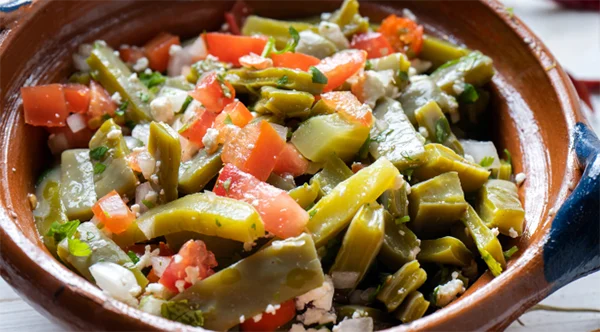
Absolutely, if you’ve been wandering through the aisles and stumbled upon those green, paddle-like veggies known as nopales, you might have paused and thought, “Can dogs eat nopales?” Well, you’re not alone in this curiosity! With the trend of feeding our furry friends natural and healthy treats on the rise, it’s only natural to wonder about introducing something new and nutritious like nopales to their diet.
Nopales are those intriguing cactus pads that catch your eye in the store, and they’re not just a treat for us humans. Rich in nutrients and low in calories, they sound like an excellent snack option for dogs. But, like introducing any new food, there are a few things to consider first.
So, let’s jump into this adventure together, exploring all there is to know about “can dogs eat nopales?” From their health benefits to the right way to prepare them for your four-legged pal, we’ll cover everything you need to know. Ready to start this exciting journey? Let’s dive in—it’s going to be both informative and fun!
What Are Nopales?

Nopales, those intriguing green paddles you’ve likely seen at the grocery store, are actually the young stems of the prickly pear cactus, native to Mexico but found in various parts of the Americas and Mediterranean regions. Not just a unique landscape feature, these cactus pads have been a staple in Mexican cuisine for centuries, loved for their tangy flavor and crunchy texture. But it’s not just their taste that’s captured the attention of foodies and health enthusiasts worldwide; it’s also their impressive nutritional profile.
Rich in vitamins (like Vitamin C and Vitamin A), minerals (such as calcium, magnesium, and potassium), fiber, and antioxidants, nopales offer a range of health benefits for humans. They’re known to help regulate blood sugar levels, improve digestion, and even support weight loss, thanks to their low calorie content and high fiber. But the big question for us pet lovers is, “Can dogs eat nopales, and do they offer the same health perks?”
The answer leans towards a yes. When prepared correctly—meaning, spines removed and cooked without any added spices—nopales can be a healthy treat for dogs. The vitamins can boost their immune system, the minerals can support bone health, and the fiber can aid in digestion. Plus, the moisture content in nopales is a nice little bonus for hydration, especially on hot days.
However, like any good thing, moderation is key. Introducing nopales into your dog’s diet should be done gradually to avoid any gastrointestinal upset, and always under the watchful eye of your vet. After all, each dog is unique, and what works for one may not work for another. So, while nopales offer promising benefits, they’re best served as an occasional treat rather than a staple in your dog’s diet.
Can Dogs Eat Nopales?
Yes, dogs can eat nopales after they’ve been properly prepared by removing spines and cooking them without any added seasonings. Nopales are rich in vitamins (like C and A), minerals (such as calcium, magnesium, and potassium), and fiber, offering various health benefits for dogs, including supporting immune function, aiding digestion, and maintaining healthy bones.
Nopales, those green cactus pads often featured in Mexican cuisine, are not only edible for humans but can also be a nutritious treat for dogs, provided they’re prepared correctly.
First off, it’s important to understand that nopales need to be de-spined and cooked (boiled or steamed) without any seasonings or oils to make them safe for canine consumption. Raw nopales or those prepared with onions, garlic, or spices could be harmful to dogs, so it’s best to keep them plain and simple.
Now, onto the good stuff – the nutritional benefits! Nopales are packed with vitamins, minerals, and fiber, making them a fantastic addition to your dog’s diet in moderation. Here’s a breakdown of the benefits:
- Vitamins: Nopales are rich in Vitamin C and Vitamin A. Vitamin C is an antioxidant that can help with immune function, while Vitamin A is crucial for maintaining healthy vision, skin, and coat.
- Minerals: These cactus pads also contain minerals like calcium, magnesium, and potassium. Calcium is vital for bone health, magnesium supports muscle and nerve function, and potassium is essential for heart health.
- Fiber: High in dietary fiber, nopales can aid in digestion and help maintain a healthy weight by promoting a feeling of fullness.
Including nopales in your dog’s diet can offer these nutritional benefits, supporting their overall health. However, as with any new food, it’s essential to introduce nopales slowly and in small amounts to ensure your dog doesn’t have an adverse reaction. Some dogs may have sensitive stomachs, so watching for signs of gastrointestinal upset is crucial.
In summary, yes, dogs can eat nopales as long as they are properly prepared and offered in moderation. These cactus pads can be a nutritious snack that provides valuable vitamins, minerals, and fiber, contributing to a balanced diet for your furry friend.
Health Benefits of Nopales for Dogs
Nopales, those green cactus pads that might seem a bit out of the ordinary for a dog’s diet, are actually packed with a bunch of nutrients that can offer some great health benefits for our four-legged friends. Let’s dive into the specifics:
Vitamins in Nopales
- Vitamin C: Unlike humans, dogs can produce Vitamin C in their bodies, but extra sources of Vitamin C from their diet can help boost their immune system, especially during stress or illness. It’s an antioxidant that fights off free radicals, reducing inflammation and potentially warding off certain diseases.
- Vitamin A: This vitamin is crucial for maintaining good vision, skin, and coat health. It helps in the development of muscles and nerves and plays a role in improving a dog’s immune function.
Minerals in Nopales
- Calcium: Essential for strong bones and teeth, calcium also plays a vital role in nerve transmission and muscle function. It’s particularly important for growing puppies and older dogs.
- Magnesium: This mineral supports muscle and nerve function and helps the body absorb other vitamins and minerals effectively. It’s also involved in energy production and contributes to bone health.
- Potassium: Necessary for proper functioning of enzymes, muscles, and nerves, potassium also helps regulate fluid balance in the body, which is essential for heart health.
How These Nutrients Support a Dog’s Health
- Immune System Support: The antioxidants in nopales, like Vitamin C, help strengthen the immune system by protecting against oxidative stress and inflammation.
- Digestion: The high fiber content in nopales can aid in digestion, promoting regular bowel movements and helping to prevent constipation. Fiber can also contribute to a feeling of fullness, which can help in weight management.
- Hydration: Nopales have a high water content, which can help keep dogs hydrated, especially during hot weather or after exercise. Proper hydration is crucial for maintaining healthy kidney function and overall well-being.
Incorporating nopales into your dog’s diet can thus offer multiple health benefits, from bolstering their immune system to supporting their digestion and helping them stay hydrated. Remember, though, that nopales should be introduced slowly and served in moderation as part of a balanced diet. And, as always, it’s best to consult with your vet before adding new foods to your dog’s meal plan, especially if your dog has specific health issues or dietary needs.
Preparing Nopales for Dogs

Preparing nopales for your dog involves a few crucial steps to ensure they are safe and enjoyable for your furry friend to eat. Here’s a simple guide to get you started:
Step 1: Cleaning and Removing Spines
- Rinse the Nopales: Begin by rinsing the nopales pads under cold water to remove any dirt.
- Remove Spines: Carefully use a vegetable peeler or a sharp knife to scrape off the spines and thorns. Make sure to remove all the small, fine spines as these can be particularly troublesome if ingested by your dog.
- Trim the Edges: Cut around the edges of the nopales to remove any remaining spiky parts.
Step 2: Cooking the Nopales
- Boil or Steam: Cooking nopales makes them easier for dogs to digest and reduces the risk of any irritation from the cactus’ slime. You can either boil them in water for about 15-20 minutes or steam them until they become soft. Avoid adding any seasonings, salt, or oil, as these can be harmful to dogs.
- Cool Down: Let the nopales cool down completely after cooking before serving them to your dog.
Step 3: Serving Suggestions and Portion Size
- Cut into Small Pieces: Once cooled, chop the nopales into small, bite-sized pieces to prevent choking and make it easier for your dog to eat.
- Portion Size: Start with a small portion, especially if your dog has never eaten nopales before. A few small pieces are sufficient to see how your dog reacts to this new food. Nopales should be considered a treat and not replace a significant portion of your dog’s regular diet.
Importance of Cooking Nopales
Cooking nopales is crucial for a few reasons. It softens the pads, making them easier to chew and digest. It also helps to eliminate the slimy texture that nopales are known for, which might be off-putting for some dogs. More importantly, cooking ensures that any potentially harmful bacteria are killed, making the nopales safer for consumption.
Introducing nopales into your dog’s diet can be a great way to add variety and extra nutrients. However, it’s essential to monitor your dog for any signs of gastrointestinal upset or allergic reactions after trying nopales for the first time. Always consult with your veterinarian before introducing new foods into your pet’s diet to ensure they’re suitable for your dog’s specific health needs.
Precautions and Considerations
When considering adding nopales to your dog’s diet, it’s essential to proceed with caution and be mindful of a few key precautions and considerations to ensure the health and safety of your furry friend.
Potential Risks of Improper Preparation
- Spines and Thorns: The most immediate risk comes from the cactus spines and thorns. If not removed thoroughly, they can cause injuries to your dog’s mouth, throat, or digestive tract.
- Raw Consumption: Feeding nopales raw can lead to gastrointestinal irritation for some dogs, due to the cactus’ fibrous nature and slimy texture when uncooked.
Warning Signs to Watch For
After introducing nopales to your dog’s diet, keep an eye out for any signs of gastrointestinal upset or allergic reactions, which may include:
- Vomiting or Diarrhea: These are common signs that your dog’s digestive system may not be handling the new food well.
- Lethargy: A sudden lack of energy or interest in usual activities could indicate discomfort or an adverse reaction.
- Itching or Hives: These could be signs of an allergic reaction to nopales, warranting immediate cessation of the new food and a consultation with your vet.
Gradual Introduction is Key
- Start Small: Introduce nopales in small amounts. A few bites are enough to start, allowing you to observe how your dog reacts over the next 24 to 48 hours.
- Monitor Closely: Pay close attention to any changes in your dog’s behavior, appetite, or bowel movements, as these can be early indicators of how well they’re tolerating the new food.
- Consult Your Vet: Before making any significant changes to your dog’s diet, including the introduction of nopales, it’s always a good idea to talk with your veterinarian. They can provide personalized advice based on your dog’s health history and dietary needs.
Consultation with a Veterinarian
When it comes to our furry companions, we all want to make sure we’re providing the best care possible, especially when it involves their diet. Introducing new foods like nopales can offer potential health benefits, but it’s crucial to emphasize the importance of consulting with a veterinarian before making any significant changes to your dog’s diet. Here’s why:
Tailored Advice for Your Dog
- Individual Health Status: Dogs, much like people, have individual health needs. A vet can assess your dog’s current health status to determine if introducing nopales or any new food is advisable. For instance, dogs with certain health conditions may require a specific balance of nutrients that nopales might disrupt.
- Dietary Needs: Dogs at different life stages have varying dietary needs. Puppies, adults, and senior dogs all require different nutrient levels. A veterinarian can provide guidance on how nopales might fit into your dog’s specific dietary requirements without causing imbalances.
- Existing Medical Conditions: If your dog has existing medical conditions, such as diabetes or kidney issues, a vet can advise whether nopales’ nutritional profile is beneficial or potentially harmful. For example, nopales are known for their blood sugar-lowering effects, which might be advantageous for some conditions but not for others.
Why Your Vet’s Input Is Invaluable
- Safety First: Your vet’s primary concern is your pet’s safety and well-being. They can advise on the safe introduction of nopales, including proper preparation methods and portion sizes, to avoid any risks associated with spines or dietary upset.
- Nutritional Balance: A veterinarian can ensure that the addition of nopales to your dog’s diet maintains nutritional balance and doesn’t inadvertently lead to nutrient excesses or deficiencies.
- Monitoring for Adverse Reactions: Your vet can inform you about potential signs of adverse reactions to watch for and advise on what steps to take if your dog doesn’t respond well to the new food.
How to Approach the Consultation
When consulting with your vet about introducing nopales or any new food into your dog’s diet:
- Be Prepared: Come with questions and any relevant information about your dog’s health history and current diet.
- Open Communication: Share your reasons for wanting to include nopales in your dog’s diet and any concerns you may have.
- Follow-Up: After introducing nopales, monitor your dog’s reaction and follow up with your vet to discuss any observed changes or concerns.
Conclusion
In conclusion, incorporating nopales into your dog’s diet can offer nutritional benefits, such as vitamins, minerals, and fiber, when prepared correctly by removing spines, cooking without seasonings, and serving in moderation. However, it’s essential to approach this with caution, starting with small amounts and closely monitoring your dog for any adverse reactions, like gastrointestinal upset or allergies. Consulting with a veterinarian before introducing nopales or any new food is crucial, as they can provide personalized advice based on your dog’s health and dietary needs. Responsible pet ownership involves being mindful of what we feed our pets, ensuring their diet enhances their health and well-being, and maintaining the special bond we share with our furry friends by prioritizing their nutritional needs and safety.



